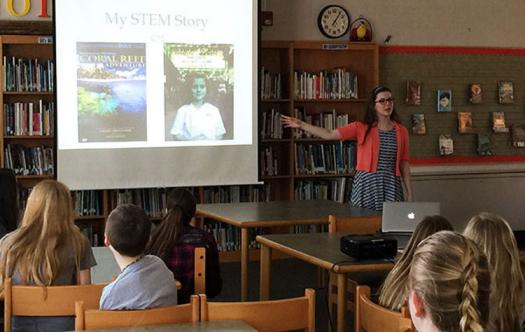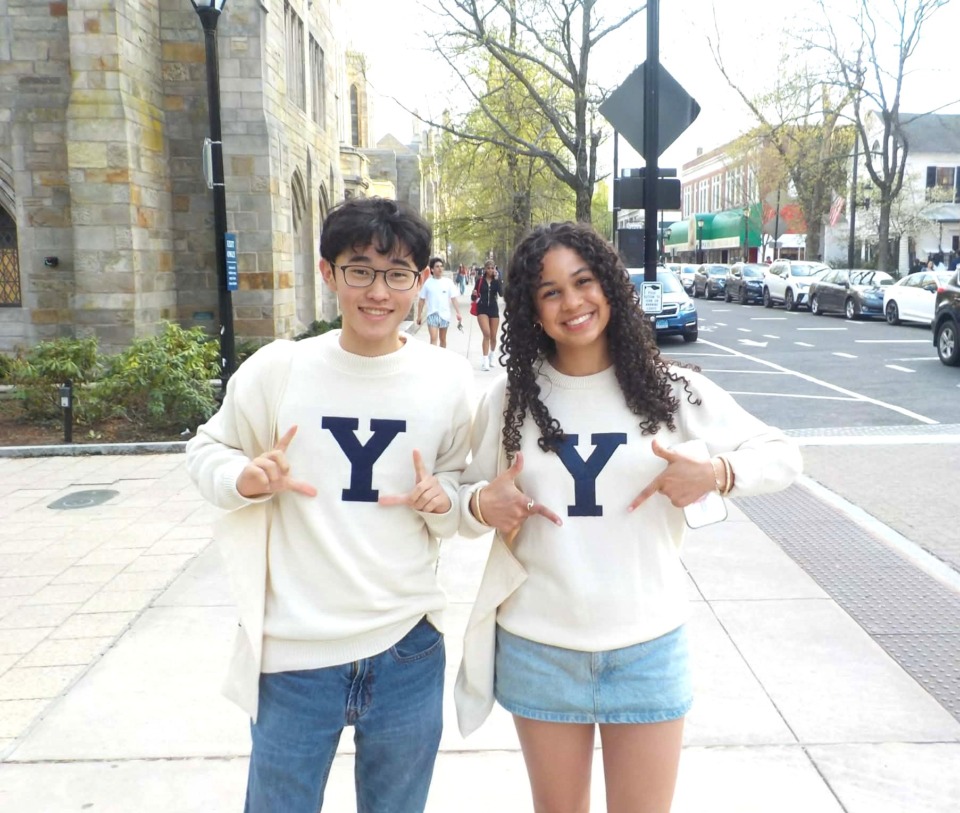Intel ISEF alumna spreads the power of STEM

After competing at Intel ISEF 2013 and 2014, Olivia Sheppard spread the wonder of STEM to more than 300 New York middle school students at schools and science museums around her state.
Olivia presented to 350 students from a diverse mix of rural, urban, private, and public schools and locations in New York, including the Museum of Science and Technology in Syracuse, Cato Middle School, Skaneateles Middle School, and Manlius Pebble Hill.

How did you come up with the idea of spreading the importance of STEM to middle school students?
After changing schools in sixth grade to Manlius Pebble Hill, a small, independent school, an awe-inspiring teacher told me: “As a girl in STEM, if you work really hard, there isn’t anything you can’t do.” Those words had a strong influence over me and encouraged me to forge a path as a young female scientist in my local community when one wasn’t readily available.
Growing up, it seemed to me that girls weren’t encouraged to pursue and study the STEM fields as much as boys. Just because something is hard doesn’t mean you can’t be good at it if you put forth the effort. By creating the outreach program, I hope the presentations I gave to local middle schools will inspire students to create their own path to follow their passions in the STEM disciplines.
I first presented in March 2014 at the Technology Alliance of Central New York (TACNY) at the Museum of Science and Technology (MOST) in Syracuse, New York. This was a part of TACNY’s Junior Café Scientifique series. The interest in my talk was so high that they moved it from a small lecture room in the museum to the IMAX theater.
What did you focus on and how did you use Science News in your presentation?
I focused primarily on the journey I’ve made throughout my school years as a result of my involvement in scientific research and science fair competition. I asked questions like: “Where do you find your inspiration for your research projects?” and “What do you enjoy reading that surrounds STEM?” I was grateful to receive the Science News magazines to distribute during my talks. Having the ability to hand out magazines to the students allowed them to see that there’s really interesting and amazing stories about a variety of scientific fields.
I remember telling my audiences that they can find inspiration in anything. Whatever their passion may be, they can turn it into a research project if they think hard enough. Whether you’re interested in launching rockets, or even testing different fabrics and materials for durability or how they respond to environmental factors because you’ve always had a passion for fashion and creating clothing, you can make it into a project! That’s what truly fascinates me and ignites my passion. The possibilities in STEM are endless.

Do you have other STEM-related projects or goals that you’re pursuing?
I am currently preparing to begin my freshman year at Stanford University, where I am excited to continue to conduct scientific research projects as a part of my studies. I am also interested in pursuing an internship at Stanford. I have already met with a researcher in the Stanford School of Medicine who is conducting groundbreaking research.
Currently my major at Stanford is undeclared, although I am interested in studying Bioengineering or Biomedical Computation. My particular interest in bioengineering is the development of drug delivery vehicles through nanotechnology. I also plan on becoming a member of the Society of Women Engineers (SWE) at Stanford and potentially continuing this outreach program to schools in the Palo Alto area. Without a doubt, my participation in my local science fair and my advancement as an Intel ISEF finalist in 2013 and 2014 set me on my current path.
What was your most memorable experience at Intel ISEF?
I drew inspiration to create my outreach program from the Nobel Laureate panel. Amazing researchers, professors, and intellectuals were sitting on stage right in front of me, but they weren’t focusing on their great discoveries or contributions to the STEM fields that awarded them the Nobel Prize. Instead, they discussed the moment they realized they were passionate about STEM, or a certain time in their childhood when they began to look at the world through a different lens. That was amazing to hear firsthand, and I believe that relaying my own personal experiences in the STEM field to middle school students might encourage them to create their own paths and pursue their interests.
Can you provide a short description of your Intel ISEF research projects?
My 2014 project focused on a potentially-implantable shunt device that could capture colon circulating tumor cells (CTC) on the inner surface and essentially filter the blood of the CTC’s by encapsulating them in a drug called TRAIL (tumor necrosis factor-reducing apoptosis inducing ligand). This would permeate the CTC’s membrane and kill the cancer cell while not harming viable cells in the bloodstream. By using halloysite nanotubes, the inner lumen of the shunt had an increased surface area, which increased the chance of CTC capture and apoptosis.

Has your involvement in Intel ISEF influenced you to pursue STEM or promote STEM to others?
My involvement in Intel ISEF has definitely influenced me to spread the message about STEM and its infinite opportunities. Students from around the world with different backgrounds and beliefs came together over a common interest in the STEM fields — it was a unifying experience. I wish that every student who is passionate about STEM was allowed the opportunity to compete at Intel ISEF.
What is your advice to young people interested in science and math?
My advice would be to read, read, read and question everything you read, see, and hear. My curiosity has allowed me to research many different areas of STEM. One of my favorite aspects of science fair competition is that each year you have the chance to study or pursue a different scientific hypothesis. The freedom that provides is amazing and I think every student should try it at least once!
I also try to find experts in the field of interest that surrounded my initial research question. Reach out to people! Don’t worry if they’re professors at universities — I often found that these professors were eager to speak with me and would answer my questions and provide direction. Strive to make connections in the fields of STEM in which you’re interested.


